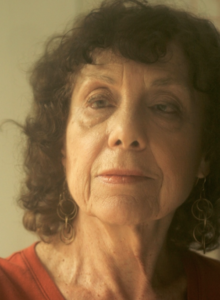BY C.M. MAYO — August 23, 2021
UPDATE: This blog was then entitled Madam Mayo (2006-2022).
“The writers I most admired as I was starting out as a fiction writer were Henry James, Proust, Gabriel Garcia Marquez, Bruno Schulz, and Natalia Ginzburg, the great Italian writer whose essays I’ve translated, A Place to Live: Selected Essays of Natalia Ginzburg, also published by Seven Stories Press, as is the anthology.”—Lynne Sharon Schwartz
This blog posts on Mondays. Fourth Mondays of the month I devote to a Q & A with a fellow writer.

Because I am a writer and literary translator myself, Lynne Sharon Schwartz’s collection Crossing Borders: Stories and Essays About Translation popped up blinking brightly on my Super-Interesting Radar (tip o’ the fez to Ellen Prentiss Campbell). Nonetheless, Crossing Borders is a book I would warmly recommend to any and all readers who appreciate superb writing and literary adventure. I relished every one of the pieces Schwartz collected, but my personal favorites were two short stories, Michelle Hermann’s “Auslander” and Lucy Ferriss’ “The Difficulty of Translation.” Triple-extra fun: Harry Mathews’ essay “Translation and the Oulipo.”
It is a delight and an honor that, for this month’s Q & A, Lynne Sharon Schwartz agreed to answer some questions.

C.M. MAYO: In brief, what inspired you to edit Crossing Borders? As the editor of an anthology of literary translations myself, I am also curious to know how you found these many and varied pieces. I know it can be quite challenging to find good pieces and to secure the permissions. (Did you send out a call for submissions?) Can you talk a little about your process?
LYNNE SHARON SCHWARTZ: As a translator as well as a writer, I’ve always been interested in the translation process, and also in fiction written about translators, which is rare. I don’t recall how the idea for the anthology came to me, but it was quite a few years ago, in fact at a time when research could be done in the library with books, not solely online. So I used a large reference book organized by topic, and I simply looked through the section on Translation; that’s how I found several of the pieces. Of course I had many more than I could use, but it was fun reading them all. Several of the stories I came across in my own personal reading, the ones by Joyce Carol Oates, Lydia Davis, Lucy Ferriss and Michael Scammell. And sometimes one thing led to another.
I didn’t send out a call for submissions, simply worked from the listings I found, and the few I discovered on my own. Securing permissions was the most onerous part of the job. Not that editors were unwilling, but in some cases finding the authors and editors, being referred from pillar to post, and that kind of thing. But most of the authors and editors were pleased to have the work included, as why shouldn’t they be?
C.M. MAYO: Which of all the pieces that came your way was the biggest surprise for you?
LYNNE SHARON SCHWARTZ: I’d have to say the most surprising was the one by Svetlana Velmar-Jancovic, “Sima Street,” which I found in An Anthology of Contemporary Serbian Stories, published by the University of Pittsburgh Press. I can’t even remember how I found it; it must have been listed in the reference book I used. Not only is it a fine story, referring to Serbian history, but how many Americans know anything about Serbian literature? It was an eye-opener and a thrill to track it down.
C.M. MAYO: As you worked to assemble this anthology, what are the one or two things about translation and/or about the process of assembling the anthology that most surprised you?
LYNNE SHARON SCHWARTZ: I was surprised by how many fine essays there are about translation, as well as the many stories whose protagonists are translators. The whole process proved fascinating. I learned a great deal by the various approaches to translation that I found.
C.M. MAYO: Was there anything that turned out to be harder and/or easier than you expected?
LYNNE SHARON SCHWARTZ: The hardest part was tracking down the works and obtaining the permissions.
C.M. MAYO: Which writers have been the most important influences for you as a writer?
LYNNE SHARON SCHWARTZ: The writers I most admired as I was starting out as a fiction writer were Henry James, Proust, Gabriel Garcia Marquez, Bruno Schulz, and Natalia Ginzburg, the great Italian writer whose essays I’ve translated, A Place to Live: Selected Essays of Natalia Ginzburg, also published by Seven Stories Press, as is the anthology.
C.M. MAYO: Which writers are you reading now?
LYNNE SHARON SCHWARTZ: I’ve read so much during this pandemic I can hardly recall them all. The one book I promised myself I would finish—and did— was the Letters of Nelson Mandela from prison. This was inspiring and brilliant, and seeing how he surmounted enormous difficulties helped me enormously. After all, getting through the pandemic doesn’t compare to what Mandela endured and achieved, and it helped me put things in perspective.
C.M. MAYO: How has the Digital Revolution affected your writing? Specifically, has it become more challenging to stay focused with the siren calls of email, texting, blogs, online newspapers and magazines, social media, and such? If so, do you have some tips and tricks you might be able to share?
LYNNE SHARON SCHWARTZ: I avoid social media as much as possible—I think it is destroying critical thinking, as well as print journalism. A lot of it is simply garbage. I do like email, though I miss getting personal letters in the mail.
C.M. MAYO: For those contemplating trying their hand at literary translation, do you have any advice?
LYNNE SHARON SCHWARTZ: Anyone trying to translate should read as much as possible in both the new language and the target language. And try to get to know the author being translated, that is by reading other works by them. I’ve always felt that my translations were successful not because of my knowledge of Italian, but rather because of my being good at writing in English!
C.M. MAYO: What’s next for you as a writer? And as a translator?
LYNNE SHARON SCHWARTZ: I’m in the middle of several things, a new novel, which seems to have stalled because of the pandemic. I’m assembling my third collection of essays, and hoping to translate an Italian Young Adult novel set in Paris at the time of the 1893 World’s Fair.
Visit Lynne Sharon Schwartz’s website at www.lynnesharonschwartz.com
I welcome your courteous comments which, should you feel so moved, you can email to me here.

Daniel Chacón’s “Words on a Wire” Podcast Interview
with Yours Truly About Francisco I. Madero’s Secret Book
Translating Contemporary Latin American Poets and Writers:
Embracing, Resisting, Escaping the Magnetic Pull of the Capital

